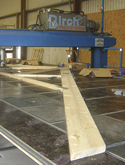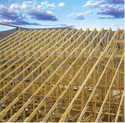Raising the rafters
20 March 2010Business is picking up for the trussed rafter sector after a rocky couple of years
Summary
• DTE’s roof truss sales in February were 30% up year-on-year.
• Pasquill Roof Trusses will open four new sites in the next eight weeks.
• Roof truss manufacturers are strengthening sales through the merchant sector.
• The rising cost of TR26 is causing concern.
The decline in housebuilding activity has had a dramatic effect on trussed rafter manufacturers over the last couple of years. With house starts plummeting from the plus 200,000 mark in 2007 to around 80,000 last year and the obvious consequence of fewer roofs to construct, the trussed rafter sector is a much leaner animal these days.
However, the tide may slowly be turning and some cautious optimism is returning to the market.
For Donaldson Timber Engineering (DTE), production is definitely on an upward trend, albeit with a weather-related dip in January. “Our daily sales of roof trusses were about £56,000 per day in December, £50,000 in January and up to £73,000 per day in February, which was certainly a lot better than we expected,” said managing director Jonathan Fellingham. “In March we’re anticipating daily sales of £82,000.
“We always experience spikes in March and April because housebuilders are trying to get their roofs on so they can get their internal work done before the end of their financial year in June, but year-on-year we’re about 30% up on February last year.”
It’s a similar story at Pasquill Roof Trusses. Two of its newest truss sites reported strong levels of output last summer, with Taunton 20% ahead of target and the Bodmin site trading at 50% of expected levels just three months after opening.
New capacity
That trend is continuing, said managing director Stuart McKill. “All our sites across the UK performed ahead of target in February and we’ll be opening four new sites in the next eight weeks. Strategically we’re very much behind our objective of taking a national position in the market and we believe we have the potential volumes to underpin all those activities going forward.”
Of course, any improvement in volumes is from a very low base across the sector and it’s a different story for margins, which are under severe pressure and not helped by the rising cost of TR26 from Scandinavia.
“There is real upward pressure on timber prices, made worse by the weakness of the pound and the uncertainty surrounding the general election,” said Philip Bell, managing director of Crendon Timber Engineering, speaking at the Trussed Rafter Association annual general meeting (see box). “There is probably more to come: prices will rise significantly for each quarter throughout 2010 and it will probably be 2011 before the prices peak and, hopefully, stabilise.”
Costs are difficult to pass on in the current market, particularly when some manufacturers are tempted to cut prices in order to secure business – a short-term measure that risks undermining future growth. “We need a profitable industry that can invest to meet the future challenges of sustainability,” said Mr Bell.
Product grades
There is no temptation to lose the faith with TR26, however. “C24 is an alternative for roof trusses but the section sizes have to increase dramatically,” said Paul Amphlett, director for engineered timber products at CR Taylor (Timber) Ltd. “A bigger section size means that any savings you make in the cubic metre cost compared to TR26 are outweighed – plus you need bigger nailplates, it’s harder to handle and so on.”
One aspect of business that has changed for many manufacturers is the customer base, which has embraced the merchant sector. “We deal with more merchants than before,” said Mr Amphlett. “I think that’s because the merchants don’t want to commit to large volumes but are keen to go out in to the market because they want to improve their own businesses.”
And he added, being a timber merchant itself has helped CR Taylor pull roof truss business through along with sales of its other products, such as I-joists.
“We’ve strengthened our position with merchants, not only with Jewson, which is our internal partner and supply chain,” said Stuart McKill. “We’ve put a lot of work into all market sectors and have made quite good inroads into the merchanting business in general – it’s been a key development for us.”
Merchant sales
DTE has also increased its sales to merchants, who now account for up to 25% of all sales – up from 15% pre-recession. “It’s largely thanks to Donaldson Group’s reputation,” said Jonathan Fellingham. “The brand sells a lot of timber direct to merchants and we’ve been able to piggy back on that to a certain degree.”
The trussed rafter sector isn’t holding its collective breath waiting for commercial or public sector construction to pick up any time soon. “The Construction Products Association forecasts a fall of 3% in 2010, then marginal growth in 2011 and says it will take until 2021 until the recovery reaches pre-recession levels,” said Philip Bell. “It also predicts a sharp fall in public sector construction post-election.
“The better news is it predicts a 15% increase in private house starts in 2010 and an 18% rise in 2011, up to 108,000.”
More good news is that the national housebuilders who are opening up new sites are including more
terraces and townhouses and slightly fewer apartments in their developments (down from the 49% market share of NHBC registrations, but still in the 40s).
The room-in-the-roof market is buoyant, particularly in Scotland where “one-and-a-half” and “two-and-a-half” storey houses are popular, but also increasingly south of the border where they are seen as a way to maximise square footage and improve the housing density per hectare.
Threat or opportunity?
It’s here that roof truss manufacturers could face their greatest threat – or opportunity. Roof cassette systems, such as Wolf Systems/Wyckham Blackwell’s smartroof and MiTek’s newly-launched
X-Rafter, are slowly nibbling away at the market share of the traditional attic truss, leading some manufacturers to put a foot in both camps. DTE, for example, is a licensed manufacturer of smartroof, while Pasquill is trialling the X-Rafter.
“Panel roofs are an opportunity for both us and the builder to add more value and change methods of construction,” said Stuart McKill. “There is a will on the part of the builders because panel roofs speed up the delivery and enable them to start work under the roof so much earlier. And when you look at the renewables market and some of the solar and tiling products that are becoming available, we can link into that and provide even more advanced solutions going forward.”
The consensus is, however, that there will always be a market for traditional roof trusses, thanks to their ability to cater for complex roof designs and their relative low cost. “In the longer term panel roof systems will definitely take away a percentage of market share but while every building needs a roof, not every building needs an attic roof, so there will always be a sizeable market for roof trusses,” said Jonathan Fellingham. “And roof trusses are always the most economical solution for building a roof.”


